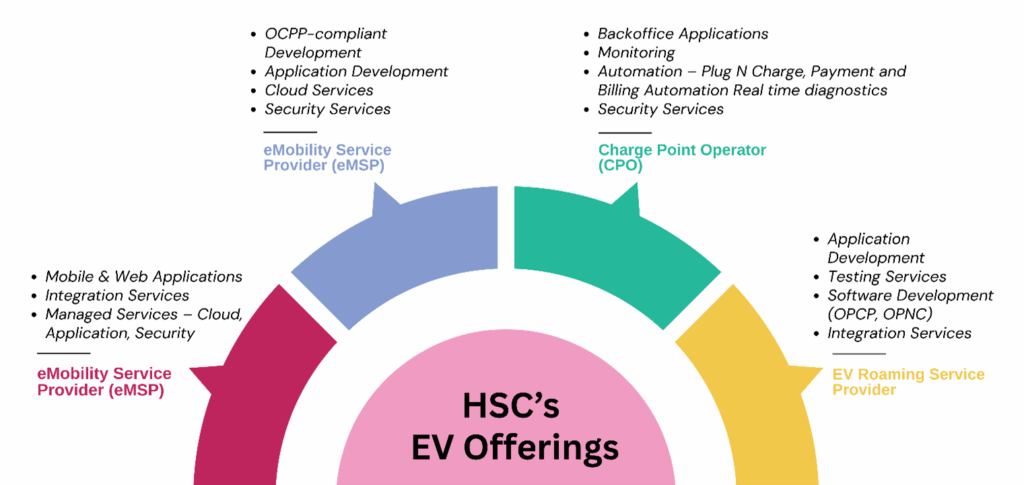Gas stations powered the last century. Electric vehicles will steer the future.
Countries globally are fast-tracking their clean transportation initiatives. Nevertheless, with the investments pouring in a critical vulnerability often goes overlooked: cybersecurity.
As per Gartner, the projected global cybersecurity spending will hit $212 billion in 2025. That’s a significant 15% jump from 2024.
This rapidly expanding electric vehicle charging infrastructure creates complex digital networks. These interconnected systems bring incredible benefits; however, they also create new vulnerabilities.
Hence, there is a pressing need for vehicle cybersecurity.
The EV charging ecosystem is highly digitized and interconnected. Along with standalone hardware, the EV charging infrastructure comprises of connected digital systems. This includes cloud computing, mobile apps, payment gateways, and vehicle integrations.
From Charge Point Operators (CPOs) to e-Mobility Service Providers (eMSPs) and grid utilities, the number of stakeholders interacting through a charging session is staggering. Each connection point becomes a potential entryway for hackers.
Read The Digital Backbone of eMobility: How IT is powering the EV Revolution
HSC offers the following software services relevant to these entities in achieving a Smart Charging Management System.

Each charging station functions as a node within an intricate digital EV ecosystem. There can be theft at multiple levels:
HSC recently implemented seamless Plug & Charge functionality for a leading digital platform provider in the electric vehicle ecosystem.
Clearly, electric vehicle cybersecurity isn’t a luxury, it’s a necessity.
Unlike fuel pumps, EV chargers require authentication before initiating sessions. Users can authenticate through smartphone apps, RFID cards, or Plug & Charge technology.
But weak or unencrypted authentication processes create serious risks. Unauthorized actors can easily spoof legitimate identities and hijack charging sessions. This highlights the need for a robust EV charging software.
One of the most promising solutions is Public Key Infrastructure (PKI). It is a cryptographic framework that authenticates and encrypts communications between chargers, vehicles, and backend servers.
In PKI system, every single device receives a unique digital certificate. This process ensures protection against impersonation and unauthorized access.
ISO 15118 powers Plug & Charge technology using this framework. It enables seamless, automatic authentication between the EV and the charging station. This cuts the required manual action, hence no risk of password leaks.
It’s not just about who connects how they communicate matters just as much.
Encryption Standards:
These security measures work together seamlessly. Think of them as our digital armor for vehicle cybersecurity.
Attackers frequently exploit unpatched firmware or outdated software in electric vehicle (EV) chargers. They change settings, block legitimate users, and sometimes damage hardware completely.
Many EV charging apps support credit cards, RFID-based access, or in-app wallets—each with its own set of vulnerabilities.
Imagine a fleet of bots bombarding a charging network’s server with fake requests, making it unavailable to actual users. This is a DDoS attack.
HSC understands that the emobility sector demands excellence beyond hardware, to ensure vehicle cybersecurity and seamless performance. Here’s how we contribute to smarter, safer, and scalable EV solutions.
HSC specializes in controlling distributed endpoint networks with precision and reliability. We have implemented systems fully compliant with industry protocols such as OCPP and OCPI. Our certificate pool management solutions ensure Plug N Charge technologies operate securely and efficiently across diverse environments.
We develop authentication and subscription services that must function flawlessly. Users expect instant access, while operators require robust security measures. Our solutions deliver both without compromise.
High-availability requirements are standard in our development approach. We design redundant systems that maintain operations even under challenging circumstances. This resilience comes from extensive experience across embedded systems, network architecture, cloud infrastructure, and cybersecurity domains.
Testing constitutes a critical component of our methodology. We offer specialized simulation environments that replicate real-world electric vehicle (EV) ecosystems. This significantly reduces operational risks across deployments. It also substantially accelerates time-to-market for new features.
We bring this deep, cross-layer experience that helps us accelerate secure innovation in EV charging and beyond.